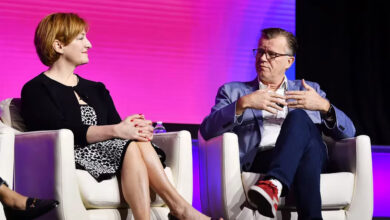The impact on finance and fintech

As we head into national general elections in the US and Europe over the coming months, many financial institutions and fintechs are wondering just what it would mean to their operational and profit models if one of the incumbent national leaders wins, or
if a current lead candidate or likely candidate (in the case of the prime minister in the UK, based on majority party choice resulting from a change in power through parliamentary elections), should defeat the sitting incumbent.
Elections are coming this summer in the UK where Prime Minister Rishi Sunak called for voting on his party’s rule on July 4th. US voters will go to the polls for national elections in November, under the guidelines of its constitution for elections every
four years for president, four years for senators, and two years for its house of representatives. Even in France, where President Emmanuel Macron seeks a second term, just called to dissolve parliament and hold ‘snap’ elections in late June and early July.
The process of choosing politicians (and evaluating their backing party’s policies) is fraught with tension and a range of possible outcomes for consumers and businesses alike.
In the US, amid broadly improving economic statistics, including increasing employment and slower than expected increases in consumer prices (inflation), the Federal Reserve announced on June 12 that it will not take action to adjust baseline interest rates
yet, though it signalled a potential rate cut might still be coming later in the year. Other countries, such as Canada, have already started to reduce central bank rates. If positive economic trends continue as they have, more nations will likely follow.
How will candidates for president and prime minister capitalise on or attack present economic conditions – indicated by interest rates, unemployment levels, and inflation figures? The answers are important to business leaders, yet their specific concerns
and priorities will vary along with their actions of support or opposition to particular parties or candidates.
It’s possible many company leaders have clear ideas of potential ramifications of various election outcomes. Executives at major firms and many smaller ones, including banks, credit unions, and non-bank financial institutions as well as their financial technology
partners are preparing to address whatever eventuality occurs.
In the world of politics, there are fundamental and potentially economic and social landscape-rocking issues being discussed at the executive branch-level in the UK and US every day. Just how different – or similar – are the potential financial policy actions
and solutions being proposed or supported by the Biden Administration and Rishi Sunak and his cabinet? What about those who oppose these chief executives – either directly or at the party policy level? What do they propose instead?
Party-level and executive priorities often differ, or at least they can change based on the realities of political office. This is no different for economic policies, like banking regulations or desired interest rate or inflation targets, for example. However,
we can start with a look at the macro-level of financial policy influence and circle back to individual topics in specific categories in future stories as this especially important election year unfolds.
Why interest rates are at the root of election outlooks
Let’s start with defining interest rates and how they are determined. From two main base rates used in both the UK and the US, many other banking-related rates are directly or ultimately derived. Not all, as some rates depend on bond purchases and sales
or other factors that are set at will by banks – as in issuing credit cards and other unsecured credit loans and obligations. That said, at the root of the rates, are two commonly discussed benchmarks used in each country.
In the U.S. the most important, most highly-quoted rate of interest that banks pay on deposits or charge for loans (within reasonable bounds) to their most preferred customers – other banks, primarily – is called the ‘Fed Funds Rate’, or ‘Effective Federal
Funds Rate’. This is a “volume-weighted median of overnight federal funds (interbank borrowing and lending) transactions” reported in a daily report published by each Federal Reserve Bank (Fed) branch. The New York Fed publishes their report for each prior
business day’s activity at 9am Eastern time every business day. In mid-June, that rate was averaging 5.33%.
In the UK, meanwhile, the equivalent main rate that is offered between preferred bank customers in-country is called the Sterling Overnight Index Average (SONIA), which in recent years since it replaced the former LIBOR or ‘London Interbank Offered Rate’ (for
domestic purposes) has reflected interest just below the ‘Official Bank Rate’, or ‘Bank Rate’ for short. The Bank Rate is set – with SONIA trends in mind, during monthly meetings by the nine members of the Monetary Policy Committee (MPC) of the Bank of England.
As of mid-June, this rate was at 5.2%, very close to where it has rested since August 2023.
Fed Funds and Bank Rate policy are influenced in part by a relatively new globally-referenced index, this being the internationally recognised as Secured Overnight Financing Rate (SOFR) – an index the New York Fed created in April 2018 to replace LIBOR and
which reflects overnight US Treasury Bond Repurchase Agreements, or loans made following the previous day to meet liquidity and reserve requirements using these bonds as collateral.
SOFR is an influence on both US and UK benchmark, or ‘target’ rates from which many other interest rates are determined by banks – notably the rates they pay on deposits (usually minus a few percentage points and fractions thereof) or for loans (usually
plus a spread of several hundred basis points, the best of which is called the ‘prime’ rate, plus additional basis points, or fractions of percentage points in units of one hundred each) for their business and consumer clients.
What the Fed or MPC does in setting target rate policies has a huge and immediate impact on what everyone with variable interest rate loan terms or credit facilities pays to borrow money, or what they earn on deposit accounts held in most financial institutions.
That is why Federal Reserve and Bank of England rate-setting policy matters a lot to presidents and other politicians at the national level, and even right on down the line to local representatives of the parties involved. It makes a significant difference
impact on banks and fintechs too.
UK monetary policy may change sooner than expected, because prime minister Sunak made the surprise decision to call for early elections. Clearly, this election will have impacts on the fortunes of Sunak’s Conservative party and very possibly the late-fall
elections in the US as well.
What might current and pending financial policies and rate actions mean to this coming November’s presidential election, where each candidate commands close to half the projected votes, or in a general parliamentary election in the UK – which could result
in a new majority party in that country and possibly a new prime minister being chosen as well.
In the US: Fed and President – often friendly, yet not joined at the hip
In the US, policy related to interest rates is under the control of the Federal Reserve
Board of Governors, headed by Jerome ‘Jay’ Powell. The seven members of this committee, usually but not always professionals from the financial services world, are nominated by
a President and confirmed by the US Senate for 14-year terms and may not be re-appointed after serving a full term.
This group’s subcommittee called the Federal Open Market Committee (FOMC) gathers eight times per year to discuss potential rate actions and other monetary policy changes. Most changes in
rates are announced on the opening Tuesday of each session, and the next one is slated for July 30-31.
The president has no direct power over Fed actions or rate adjustments, though they do have influence over policy to an extent because of their role in electing new governors every two even-numbered years. Also, if a member of the FOMC either finishes their
term, dies in office, or resigns around that time, a sitting president may have the opportunity to directly nominate one or more governors in a brief period.
Depending on the political makeup of the US Senate when this nomination occurs, this could influence the success or failure of the nominee to gain confirmation, notwithstanding legitimate discussion of their professional qualifications for the role.
Important note: the president and senate also may nominate and confirm candidates for Chair and Vice Chair of the Federal Reserve Board, as well as Vice Chair for Supervision. This could provide additional avenues for exerting additional influence, political
or otherwise, on board positions and ultimately the direction of monetary policy decisions.
President Biden
reappointed Fed Chief Powell to a second term as Fed Chair after his defeat of former president Trump in 2020’s election, with his choice in early 2021 viewed as signalling “continuity” and agreement with the central bank’s decisions – even amid rising,
primarily pandemic-related inflation concerns at that time.
In doing so, he passed over another candidate for Powell’s job, Lael Brainard, instead re-nominating her to serve as Vice Chair of the Fed’s Board. Brainard had been nominated as a Fed governor by former president Barack Obama in 2014, as had Powell. After
around eight and a half years in the position, Brainard was appointed in February 2023 as Director of the National Economic Council and concurrently serves as chair of the White House Competition Council.
Most readers know just how influential the Federal Reserve is when it comes to US and even global interest rates. Recently, the Fed’s leaders have been hesitant to keep raising rates above the several increases they enacted in 2022 to help curb inflation.
This reticence is widely projected to continue, at least for the next cycle or two as inflationary pressures ease in the U.S.
Sunak and Biden: Stable or dropping rates huge help to re-election hopes?
Though they occupy different points along the political spectrum, President Biden, as well as Prime Minister Sunak in the UK, would both prefer for interest rates like Fed Funds and Bank Rate to remain where they are, or even to go a bit lower through the
rest of 2024. This would stabilise or possibly reduce the rates citizens of both countries pay for variable interest debt obligations in most cases, and by extension provide consumers with reasons to be more optimistic about spending money to help improve
the economy, buy homes, and more. Lower or stable bank or bank-derived borrowing rates could also stimulate businesses and other organisations to hire more workers or make greater investments in new equipment and to fund expansions of operations.
Generally speaking, when the economy is healthy, and no other major factors, issues, or particularly strong opposing candidates exert unusual influence on the political process, US presidents or UK prime ministers seeking a second term – the maximum permitted
under US Constitution- or continued service (in the case of the UK) usually get re-elected or kept in office.
Conversely, when the economy is struggling; unemployment is higher than average, inflation is higher than desired, or interest rates on unsecured loans or mortgages (the latter typically priced based on a number of factors including other government- issued
financial instruments as well as the Fed Funds rate) are steeper than in past years, the challenger has a much greater chance of winning the election.
Recent
polls continue to show that some voters aren’t giving Biden as much credit as he might hope for lower rates or slowing inflation. However, that could change as election day nears. Most Americans, for example, have heard once, twice, or a thousand times
a particularly sharp bromide uttered in 1992 by political strategist James Carville to then presidential candidate Bill Clinton, to describe the main election issue facing Clinton and incumbent President George Bush. It’s widely held to be a similarly important
factor for the majority of any given presidential electorate, no matter what the year: “It’s the economy, stupid!”
So, lower rates in one, or many, key areas in the UK, US, and countries around the globe offer strong points in any president’s or prime minister’s favour, if they want to be re-elected. That said, they are obviously not the only ones, and many other factors,
even beyond financial matters, are also involved. However, interest rates are extremely impactful to all segments of the economy. Banks and other financial institutions – and businesses of all kinds, including fintechs, generally benefit most from interest
rates that provide lower borrowing or reasonably high deposit rates to help power their business activities and earnings on idle cash. In the case of financial institutions or fintechs engaged heavily in embedded finance products and services, with proper
margins in place above these base interest rates, they can manage to profitably lend to consumers and businesses based on their lower costs paid on deposits to fund those lending obligations.
What could change the outlook for the US president, and perhaps the UK PM?
Big changes in economic conditions over the next three months, or some major event to cause major swings in consumer and business interest rates charged by banks during that time could increase the negative or positive impacts overall of interest rates on
the coming general elections later this year.
It’s unlikely that such dramatic moves would come from changes in the composition or planned actions of the US’s Federal Reserve Board or UK’s Monetary Policy Committee given their reputations for prudence and long tenures. So, it would likely have to be
something else that shakes up the markets, such as stock market corrections or increases, major changes in employment or productivity data, higher or lower inflation, supply chain or other pricing spikes or drops caused by unfavourable or fairer weather, or
numerous other influential economic factors.
What’s next in Finextra’s study of key factors for banks and fintechs to consider this election year?
The next topic of discussion will be rising inflation rates. Since 2021, the monthly-charted, annualised
US inflation rate rose steadily to as high as 9% until beginning to decline in July of 2022. The current rate (from mid-June 2024) is 3.3% Meanwhile, in the UK, the current inflation rate sits at
3%, though it had reached as high as 9.6% in October of 2022 before starting its decline to the present.
What impact will changes in inflation rates, and specifically increases or decreases in key consumer and business expenses. mean to financial services and fintechs this election year? Check back with us for the next story in our Finextra series.



